Ruta de navegación
Blogs
Entradas con etiqueta brazil .
The constant expansion of soy production within the MERCOSUR countries exceeds 50% of total world production
While many typically associate South American commodities with hydrocarbons and minerals, soy or soybean is the other great commodity of the region. Today, soy is the agricultural product with the highest commercial growth rate in the world. China and India lead world consumption of this oleaginous plant and its byproducts, thus making South America a strategic supplier. Soy profitability has encouraged the expansion of crop production, especially in Brazil and Argentina, as well as in Paraguay, Bolivia and Uruguay. However, such expansion comes at an environmental cost; such as recent deforestation in the Amazon and the Gran Chaco.
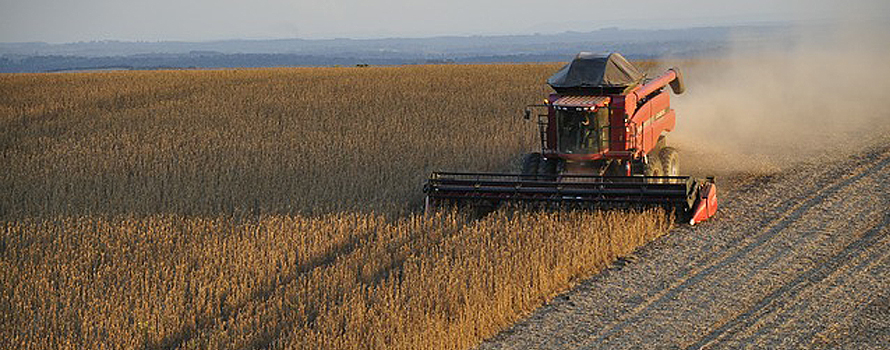
ARTICLE / Daniel Andrés Llonch [Spanish version]
Soy has been cultivated in Asian civilizations for thousands of years; today its cultivation is also widespread in other parts of the world. It has become the most important oilseed for human consumption and animal feed. Of great nutritional properties, due to its high protein content, soybeans are sold both in grain and in their oil and flour derivatives.
Among the eleven largest soybean producers, five are in South America: Brazil, Argentina, Paraguay, Bolivia and Uruguay. In 2016, these countries were the origin of 50.6% of world production, whose total reached 334.8 million tons, according to FAO data. The first producer was the United States (34.9% of world production), followed by Brazil (28.7%) and Argentina (17.5%). India and China follow the list, although what is significant about this last country is its large consumption, which in 2016 forced it to import 83.2 million tons. Much of these import needs are covered from South America. Furthermore, the South American production focuses on the Mercosur nations (in addition to Brazil and Argentina, also Paraguay and Uruguay) and Bolivia.
The strong international demand and the high relative profitability of soybean in recent years has fueled the expansion of the cultivation of this plant in the Mercosur region. The price boom for raw materials, which also involved soy, led to benefits that were directed to the acquisition of new land and equipment, which allowed producers to increase their scale and efficiency.
In Argentina, Bolivia, Brazil and Paraguay the area planted with soybeans represents the majority (it constitutes more than 50% of the total area sown with the five most important crops in each country). If we add Uruguay, where soybean has enjoyed a later expansion, we have that the production of these five South American countries has gone from 99 million tons in 2006 to 169.7 million in 2016, which constitutes a rise of 71%. , 2% (Brazil and Bolivia have almost doubled their production, somewhat exceeded by Paraguay and Uruguay, where it has tripled). In the decade, this South American area has gone from contributing 44.7% of world production to 50.6%. At that time, the cultivated area increased from 40.6 million hectares to 58.4 million.
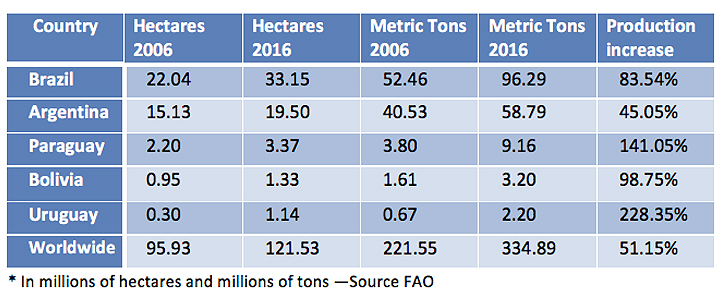 |
Countries
As the second largest producer of soybeans in the world, Brazil reached 96.2 million tons in 2016 (28.7% of the world total), with a cultivation area of 33.1 million hectares. Its production has been in a constant increasement, so that in the last decade the volume of the harvest has increased by 83.5%. The jump has been especially notable in the last four years, in which Brazil and Argentina have experienced the highest growth rate of the crop, with an annual average of 936,000 and 878,000 hectares, respectively, according to the United States Department of Agriculture. (USDA).
Argentina is the second largest producer of Mercosur, with 58.7 million tons (17.5% of world production) and a cultivated area of 19.5 million hectares. Soybeans began to be planted in Argentina in the mid-70s, and in less than 40 years it has had an unprecedented advance. This crop occupies 63% of the areas of the country planted with the five most important crops, compared to 28% of the area occupied by corn and wheat.
Paraguay, for its part, had a harvest of 9.1 million tons of soybeans in 2016 (2.7% of world production). In recent seasons, soy production has increased as more land is allocated for cultivation. According to the USDA, in the last two decades, the land dedicated to the cultivation of soybeans has constantly increased by 6% annually. Paraguay currently has 3.3 million hectares of land dedicated to this activity, which constitutes 66% of the land used for the main crops.
As far as Bolivia is concerned, soybeans are grown mainly in the Santa Cruz region. According to the USDA, it represents 3% of the country's Gross Domestic Product, and employs 45,000 workers directly. In 2016, the country harvested 3.2 million tons (0.9% of world production), in an area of 1.3 million hectares
Soybean plantations occupy more than 60 percent of Uruguay's arable land, where soybean production has been increasing in recent years. In fact, it is the country where production has grown the most in relative terms in the last decade (67.7%), reaching 2.2 million tons in 2016 and a cultivated area of 1.1 million hectares.
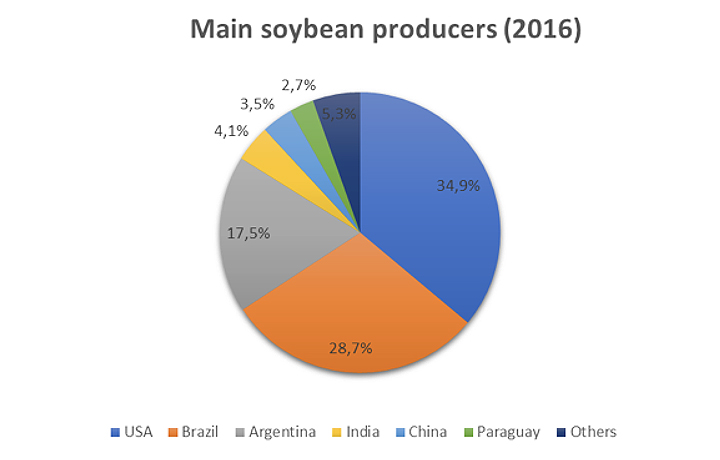 |
Increase of the demand
The production of soy represents a very important fraction in the agricultural GDP of the South American nations. The five countries mentioned together with the United States make up 85.6% of global production, so they are the main suppliers of the growing global demand.
This production has experienced a progressive increase since its insertion in the market, with the exception of Uruguay, whose product expansion has been more recent. In the period between 1980 and 2005, for example, the total world demand for soybean expanded by 174.3 million tons, or what is the same, 2.8 times. In this period, the growth rate of global demand accelerated, from 3% annually in the 1980s to 5.6% annually in the last decade.
In all the South American countries mentioned, the cultivation of soy has been especially encouraged, because of the benefits that it entails. Thus, in Brazil, the largest regional producer of oilseed, soybean provides an estimated income of 10,000 million dollars in exports, representing 14% of the total products marketed by the country. In Argentina, soybean cultivation went from representing 10.6% of agricultural production in 1980/81 to more than 50% in 2012/2013, generating significant economic benefits.
The outlook for growth in demand suggests a continuation of the increase in production. The United Nations Food and Agriculture Organization estimates that global production will exceed 500 million tons in 2050, which doubles the volume harvested in 2010 and clearly, much of that demand will have to be met from South America.
The Russian positioning system GLONASS has placed ground stations in Brazil and Nicaragua; the different accessibility of them to nationals gives rise to conjectures
At a time when Russia has declared its interest in having new military facilities in the Caribbean, the opening of a Russian station in the Managua area has raised some suspicions. Roscosmos, the Russian space agency, has opened four stations in Brazil, managed with transparency and easy access; instead, the one that has built in Nicaragua is surrounded by secrecy. What little is known about the Nicaraguan station, strangely greater than the others, contrasts with the openly that data can be collected on the Brazilians.
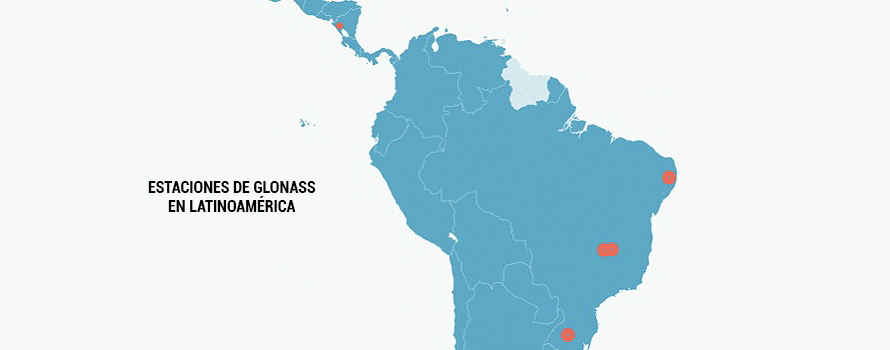
ARTICLE / Jakub Hodek [Spanish version]
We know that information is power. The more information you have and manage, the more power you enjoy. This approach must be taken into account when examining the ground stations that serve to support the Russian satellite navigation system and its construction in relative proximity to the United States. Of course we are no longer in the Cold War period, but some of the traumas of those old times may help us to better understand the cautious position of the United States and the importance that Russia sees in having its facilities in Brazil and especially in Nicaragua.
That historical background of the Cold War is at the origin of the two largest navigation systems we use today. The United States launched the Global Positioning System (GPS) project in the year 1973, and possibly in response, the Soviet Union presented its own positioning System (GLONASS) three years later. [1] It has been almost 45 years, and these two systems no longer serve Russians and Americans to try to get information on each other, but are collaborating and thus offering a more accurate and fast navigation system for consumers who buy a Smartphone or other electronic device. [2]
However, in order to achieve global coverage, both systems need not only satellites, but also ground stations strategically distributed around the world. For that purpose, the Russian Federal Space Agency, Roscosmos has erected stations for the GLONASS system in Russia, Antarctica and South Africa, as well as in the Western Hemisphere: it has four stations in Brazil and since April 2017 has one in Nicaragua, which by secrecy around its purpose has caused mistrust and suspicion in the United States [3] (USA, for its part, has ground stations for GPS in its territory and Australia, Argentina, United Kingdom, Bahrain, Ecuador, South Korea, Tahiti, South Africa and New Zealand).
The Russian Global Satellite Navigation System (Globalnaya Navigatsionnaya Sputnikovaya sistema or GLONASS) is a positioning system operated by the Russian Aerospace Defence Forces. It consists of 28 satellites, allowing real-time positioning and speed data for the surface, sea and airborne objects around the world. [4] In principle GLONASS does not transmit any personally identifiable information; in fact, user devices only receive signals from satellites, without transmitting anything back. However, it was originally developed with military applications in mind and carries encrypted signals that are supposed to provide higher resolutions to authorized military users (same as the US GPS). [5]
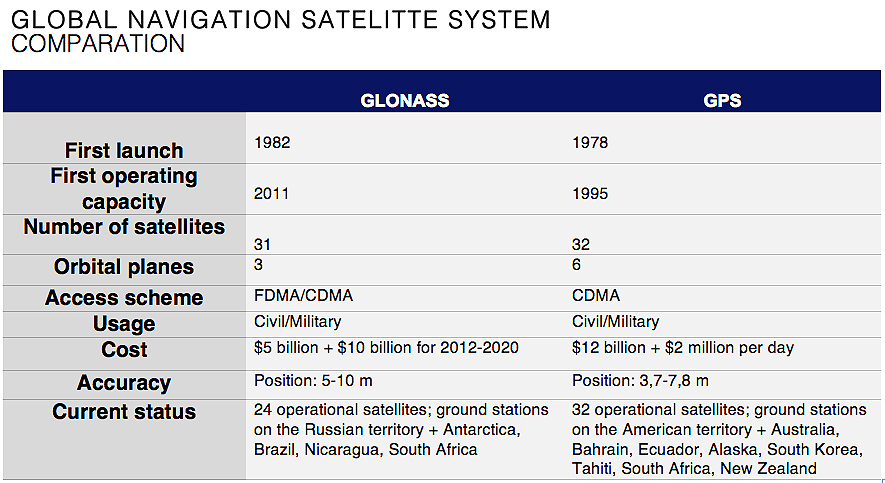 |
In Brazil, there are four Earth stations that are used to track signals from the GLONASS constellation. These stations serve as correction points in the Western hemisphere and help significantly improve the accuracy of navigational signals. Russia is in close and transparent collaboration with the Brazilian Space Agency (AEB), promoting research and development of the aerospace sector of this South American country. In 2013 the first station was installed, located on the campus of the University of Brasilia, which was also the first Russian station of that type abroad. It followed another station in the same place in 2014, and later, in 2016, a third was put in the Federal Institute of Sciences of the education and technology of Pernambuco, in Recife. The Russian Federal Space agency Roscosmos built its fourth Brazilian station on the territory of the Federal University of Santa Maria, in Rio Grande del Sur. In addition to fulfilling its main purpose of increasing accuracy and improving the performance of GLONASS, the facilities can be used by Brazilian scientists to carry out other types of scientific research. [6]
The level of transparency that surrounded the construction and then has prevailed in the management of the stations in Brazil is definitely not the same as the one applied in Managua, the capital of Nicaragua. There are several information that create doubts regarding the true use of the station. For starters, there is no information about the cost of the facilities or about the specialization of the staff. The fact that the station has been put at a short distance from the U.S. Embassy has given rise to conjecture about its use for phone-tapping and spying.
In addition, the vague replies from the representatives of Nicaragua and Roscosmos about the use of the station, have not managed to transmit confidence in the project. It is a "strategic project" for both Nicaragua and Russia, concluded Laureano Ortega, the son of the Nicaraguan president. Both countries claim to have very fluid and close cooperation in many areas, such as in health and development projects. However, none of those collaborations have materialized with such speed and dedication as this particular project. [7]
Given Russia's larger military presence in Nicaragua, empowered by the agreement that facilitates the mooring of Russian warships in Nicaragua announced by Russian Defense Minister Sergei Shoigu during his visit to the Central American country in February 2015, and specified also in the donation of 50 T-72B1 Russian tanks in 2016 and the increased movement of the Russian military personnel, it can be concluded that Russia clearly sees strategic importance in its presence in Nicaragua. [8] [9] This is all observed with suspicion from America. The head of South American Command, Kirt Tidd, warned in April that "the Russians are moving forward a disturbing attitude" in Nicaragua, which "impacts the stability of the region."
Without a doubt, when world powers like Russia or the United States act outside their territory, they are always guided by a combination of motivations. Strategic positioning is essential in the game of world politics. For this very reason, the aid that a country receives or the collaboration it can establish with a great power is often subject to political conditionality.
In this case, it is difficult to know for sure what is the purpose of the station in Nicaragua or even those of Brazil. At first glance, the objective seems neutral – offering higher quality navigation system and providing a different option to GPS –, but given the new importance that Russia is granting to its geopolitical capabilities, there is the possibility of more strategic use.
